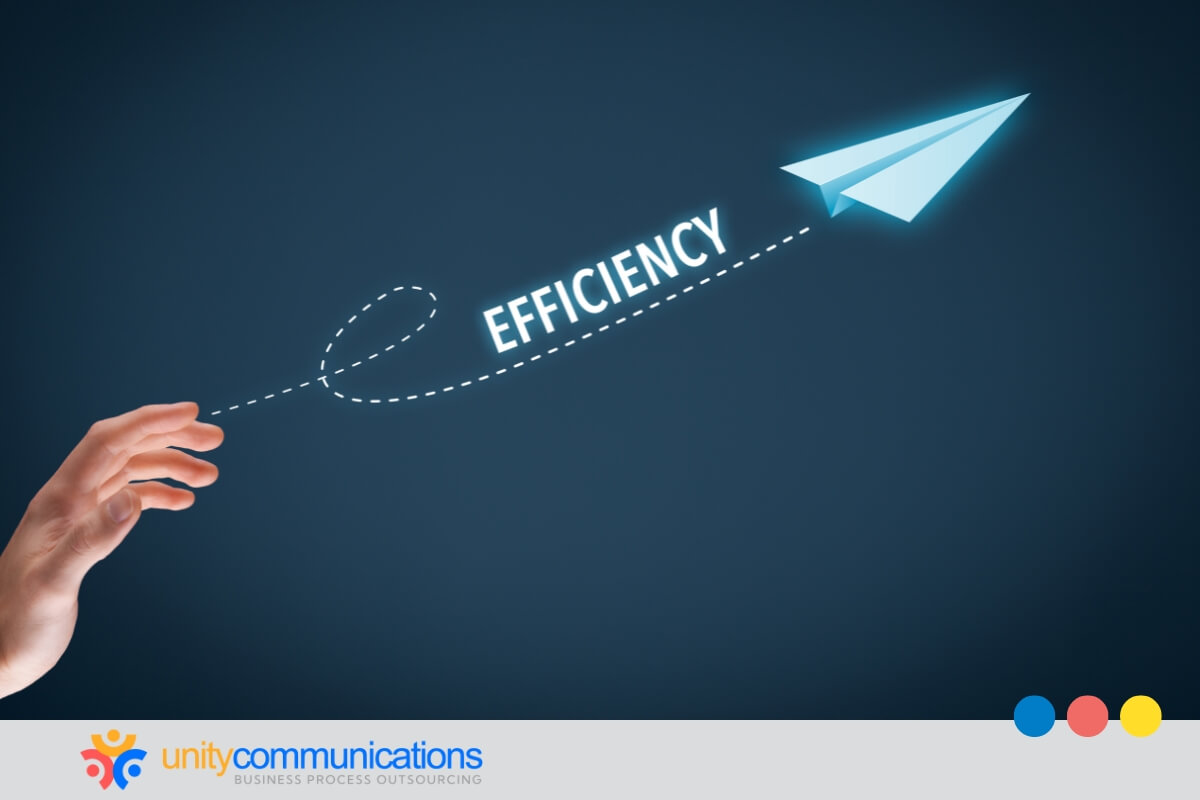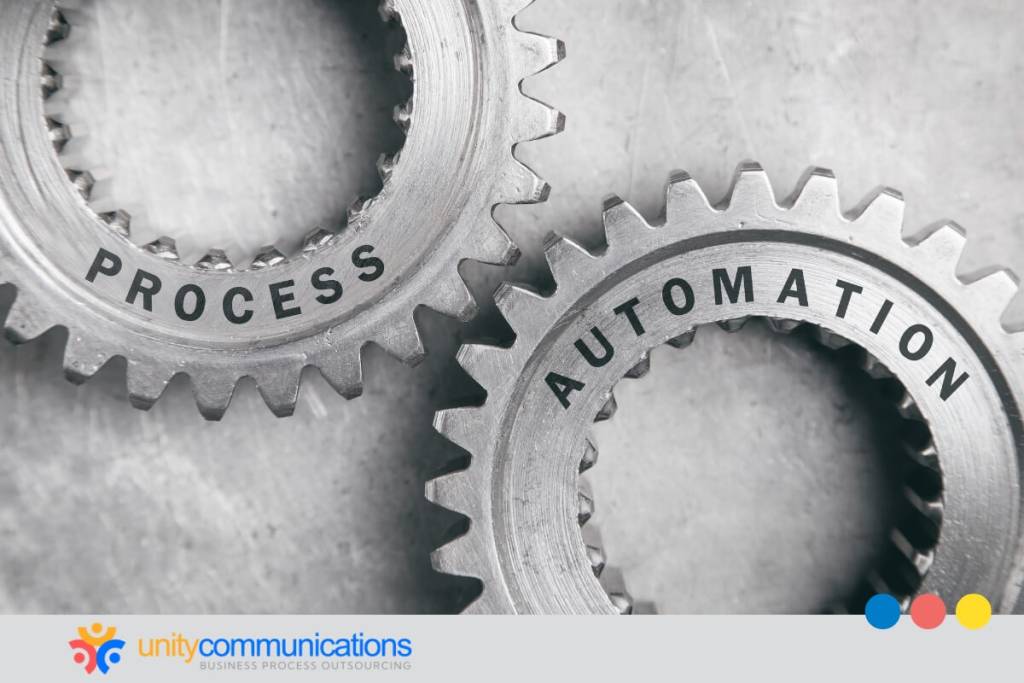Table of Contents
In today’s highly competitive business landscape, organizations constantly search for innovative ways to stay ahead and thrive.
Business process outsourcing (BPO) has emerged as a strategic approach to boosting efficiency, streamlining operations, and reducing costs. Process automation has also become a powerful tool to further accelerate productivity, output, and revenue.
Companies leverage automation within BPO operations to maximize their return on investment (ROI).
Keep reading to learn how to measure BPO success by evaluating the effectiveness of process automation and the boost in ROI that it brings.
The interplay between BPO and process automation ROI

What is BPO, and how does it relate to process automation ROI?
BPO entails designating specific organizational tasks to service providers with specialized knowledge and resources. Conversely, process automation ROI measures the monetary rewards of automating processes against implementation and maintenance expenses.
The dramatic improvements in operational efficiency and profitability brought about by integrating business process automation are critical examples of how technology is changing the BPO industry. Check the synergy:
Complementary strengths
BPO providers bring industry-specific knowledge and skills, which can lead to remarkable improvements when combined with process automation.
Automation technologies, such as robotic process automation (RPA) and intelligent automation, handle repetitive tasks precisely and quickly, allowing human workers to focus on more complex and value-added activities. Examples include strategic planning, creative problem-solving, and customer relationship management (CRM).
Enhanced efficiency and cost savings
Automating routine and repetitive processes, such as data entry and invoicing, can dramatically cut expenses. It also reduces errors, lowering the need for costly adjustments while improving overall process quality.
Furthermore, automated processes can run around the clock, raising throughput and meeting high-volume demands without increasing labor spending.
Qualitative benefits
Beyond noticeable cost savings, BPO and process automation provide qualitative advantages that contribute to higher ROI and long-term organizational success and sustainability.
These benefits include improved customer experiences due to faster and more accurate service delivery and higher employee satisfaction as workers are relieved of tedious activities.
The integration also enhances process improvement through constant and real-time data analysis. Identifying and correcting inefficiencies and bottlenecks is quick, optimizing resources and streamlining operations for better performance.
Increased scalability and flexibility
Pairing outsourcing with process automation enables firms to scale their operations more effectively. This BPO tech adjusts to shifting workloads without requiring equivalent increases in personnel.
This flexibility allows firms to meet fluctuating market needs and seasonal peaks without sacrificing performance or incurring additional costs. It also enables businesses to adapt quickly to new opportunities and challenges to stay ahead of the curve.
How to measure BPO and process automation ROI

Measuring the profitability of utilizing BPO and process automation requires a systematic approach. Apply the following steps to capture the full impact of your investments:
Define objectives and scope
Identify your goals for BPO and automation, whether increased cost savings, higher efficiency, improved accuracy, or happier customers. Determine the scope of the functions to outsource to a BPO vendor and automate to establish clear expectations and boundaries for the initiative.
Establish baseline metrics
Measure the current performance of the outsourced and automated processes. Key performance indicators (KPIs) include processing times, error rates, labor costs, and customer satisfaction. Calculate the costs, such as personnel, overhead, and technology, to provide a financial baseline.
Calculate costs of BPO and automation
Estimate your initial investment, including technology, software, hardware, and installation charges for BPO services. Calculate the implementation costs for integration, training, and any anticipated downtime during the changeover. Include ongoing expenses, such as maintenance, upgrades, and operating fees for outsourced services and automation tools.
Monitor post-implementation performance
Regularly track and collect data on the same parameters with the BPO organization to assess changes and improvements following implementation. Set a time frame. Allow enough time to collect credible post-implementation data to compare to baseline KPIs accurately and evaluate the efficacy of BPO and process automation activities.
Quantify benefits
Calculate the cost savings by reducing labor, error correction, and operating expenses. Track processing times, throughput, and productivity increases to calculate efficiency gains. Compute error rates to measure quality improvements in customer service and compliance.
Calculate return on investment (ROI)
Use this formula to calculate when integrating BPO with process automation to determine your ROI:
ROI = [(total benefits − total costs)/total costs] x 100
The outcome is a percentage representing the profit earned on every dollar spent on outsourcing and automation. A high ROI indicates lucrative BPO and automation benefits, such as reduced operational costs, increased productivity, and higher overall profitability.
Application: Measuring ROI of process automation in a BPO initiative

To illustrate the practical application of these principles, examine the following case study:
DPA Inc., a financial services firm, sought to outsource and automate its invoice processing function to save money and increase productivity. It collaborated with UCPB BPO Services to implement an innovative RPA solution.
Let us apply the BPO and process automation ROI approach outlined above:
- Define objectives. DPA Inc. wanted to cut operating expenses by 30%, enhance processing speed by 50%, and boost accuracy to nearly 100%. The project aimed to automate the invoice processing function, which included data entry, validation, and reporting.
- Establish baseline metrics. The current manual method required an average of 10 minutes for each invoice, had a 5% error rate, and cost $5. The monthly labor costs for invoice processing were $20,000 plus $5,000 in overhead expenditures.
- Calculate costs of BPO and automation. The RPA solution and setup fees totaled $50,000. The integration and training costs were $10,000, while the expected transition downtime cost was $2,000. The whole amount is $12,000. Monthly maintenance and operating costs for the automation tools and BPO services were $3,000.
Once DPA Inc. has this initial information and benchmarks prepared, it can begin collecting and evaluating performance data for six months after deployment.
At the end of this evaluation period, they determine the following quantitative benefits:
- Cost savings. Labor costs decreased by 70%; savings, $14,000 monthly; and error correction costs, $2,000 monthly. Calculated cost savings: $14,000 + $2,000 = $16,000.
- Efficiency gains. Processing time decreased to 2 minutes per invoice, increasing throughput by 400%. Calculated gains: $3,000.
- Quality improvements. Error rates fell to less than 0.5%, enhancing compliance and customer satisfaction. Calculated quality improvements: $2,000.
To calculate DPA Inc.’s ROI, the following formula was applied:
- Total benefits. $16,000 (cost savings) + $3,000 (efficiency gains) + $2,000 (quality improvements) = $21,000/monthly. Six months x $21,000 = $126,000.
- Total costs. Initial investment (one-time spending) + implementation costs (one-time expense) + ongoing costs = $50,000 + $12,000 + $18,000 (6 x $3,000/monthly) = $80,000.
- ROI formula. ROI = [(total benefits − total costs)/total costs] x 100
ROI = [($126,000 − $80,000)/$80,000] x 100 = 57.5%
Based on the ROI calculations, DPA Inc. achieved a 57.5% positive return within six months by outsourcing and automating invoice processing. This example case shows significant cost savings, efficiency gains, and quality improvements from BPO and process automation, emphasizing the importance of thorough planning, monitoring, and analysis.
The bottom line
Outsourcing and process automation synergy improves customer experiences, employee satisfaction, and real-time process improvements. Measuring BPO and process automation ROI involves defining objectives, establishing baseline metrics, calculating costs, and monitoring performance.
Let’s connect to learn more about maximizing BPO and process automation ROI. Unity Communications can help you improve operations, lower costs, and drive efficiency through tailored outsourcing and automation solutions!




